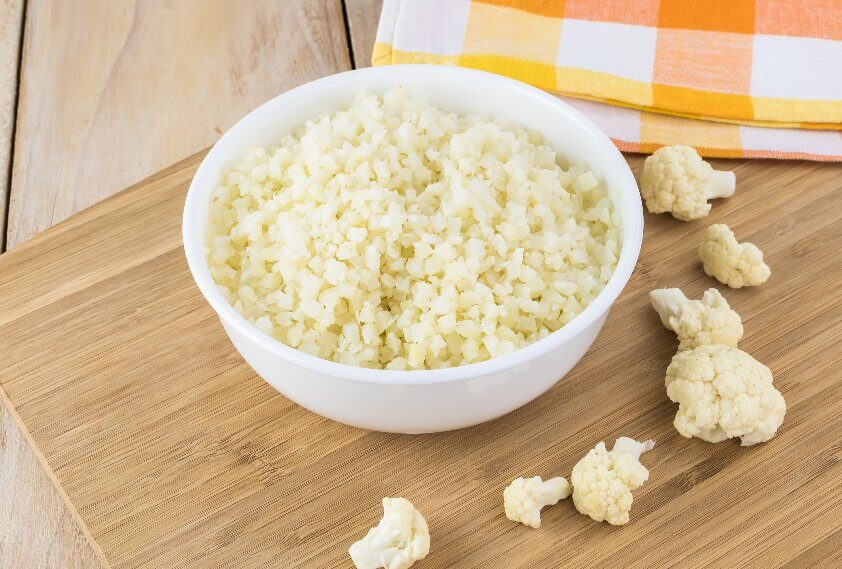In an article from last week, we went over some of the pros and cons of opting for cauliflower rice over white rice. As you could imagine, cauliflower rice has much more to offer in terms of nutritional value– especially when compared to a refined grain such as white rice. What about brown rice, though? Seeing as how brown rice is more nutritionally advantageous than white rice, weighing cauliflower rice vs brown rice would seem to be a more fair comparison to make. Let’s have a closer look.
Choosing between cauliflower rice vs brown rice boils down to nutritional preference. Cauliflower rice is lower in calories, lower on the Glycemic Index, and is Keto-friendly. Brown rice, on the other hand, packs more protein, fiber, vitamins, and minerals.
That said, there are other factors to take into consideration. Let’s dig in.
What’s The Deal With Cauliflower Rice?
Did you know that cauliflower rice isn’t actually rice? As it turns out, it’s just tiny little florets of cauliflower that have been rinsed and diced into rice-sized grains.

Cauliflower rice mimics the texture and appearance of traditional rice when consumed raw, but it can also be lightly sauteed in oil for a firmer texture.
Once prepared, it can be used in all of the same ways regular rice can, whether it be for making sushi, used as a bed for stir-fries, and even made into fried rice.
Health-conscious consumers opt for cauliflower rice over traditional rice due to the numerous health benefits of cauliflower.
Cauliflower Rice VS Brown Rice
The health benefits of opting for brown rice over white rice are hardly a secret by now. Brown rice packs more protein, fiber, and minerals than white rice does, making it a more nutritionally-advantageous choice.
What about cauliflower rice vs brown rice though? Let’s have a look at the nutrition facts for each:
| Item | Cauliflower Rice | Brown Rice |
 |
 |
|
| Serving Size | 1 Cup, chopped | 1 Cup, cooked |
| Calories | 25 | 248 |
| Total Carbohydrates | 5.3 g | 52 g |
| Dietary Fiber | 2.5 g | 3.2 g |
| Sugar | 2.4 g | 0.5 g |
| Total Fat | 0.1 g | 2 g |
| Saturated Fat | 0.0 g | 0.5 g |
| Protein | 2g | 5.5 g |
| Sodium | 30 mg | 8.1 mg |
| Potassium | 9% DV | 4% DV |
| Magnesium | 4% DV | 19% DV |
| Calcium | 2% DV | 0% DV |
| Iron | 2% DV | 6% DV |
| Zinc | 2% DV | 13% DV |
| Copper | 2% DV | 23% DV |
| Vitamin C | 77% DV | 0% DV |
| Vitamin K | 20% DV | 0% DV |
| Vitamin B6 | 11% DV | 15% DV |
As you can see, there’s a lot to unpack here. The nutritional benefits of each can vary, and the better option may be the one that best suits your dietary goals. Let’s examine.
Why Brown Rice Is Better
Let’s have a look at some of the nutritional advantages that brown rice has over cauliflower rice.
1. Brown Rice Is More Satiating
Based on a 1-cup serving size, brown rice packs nearly ten times as many calories as cauliflower rice.
This means that there is more energy (calories = units of energy) to be derived from a single serving of brown rice, helping you feel full longer.
2. It Also Contains More Fiber
Not only does it contain more calories, but brown rice also delivers more fiber with each bite, clocking in at 3.2 grams per 1-cup serving.
Fiber is an indigestible type of carbohydrate that comes with many health benefits. According to Mayo Clinic, fiber consumption is associated with:
- Normalized bowel movements
- Lower cholesterol levels
- Weight loss
- Blood sugar control
- And more
By comparison, an equal serving size of cauliflower rice only contains 2.5 grams of fiber– roughly one-third less than brown rice.
3. Brown Rice Packs More Protein
Protein is essential for building and repairing muscle tissue, and can even help boost metabolism, says Healthline.
Getting adequate amounts of protein on a plant-based diet can be tricky– especially for athletes and fitness enthusiasts alike who may require more of it than the average sedentary person.
If protein is a priority for you then brown rice would clearly be the wise option, as it contains nearly three times as much per serving, coming in at 5.5 grams of protein per cup.
Comparatively, a cup of cauliflower rice only has 2 grams of protein.
4. Brown Rice Is Loaded With Vitamins & Minerals
While it’s true that both cauliflower rice and brown rice have much to offer in terms of vitamins & minerals, this is an area where the latter seems to shine a bit brighter.
Per serving, brown rice contains more:
- Magnesium: a mineral that helps regular muscle and nerve function
- Iron: a mineral that helps transport oxygen in the blood
- Zinc: a trace mineral that helps support healthy immune function
- Copper: a mineral that helps make connective tissue and blood vessels
- Vitamin B6: a nutrient that helps keep the nervous system healthy
Why Cauliflower Rice Is Better
Now let’s have a look at some of the reasons why you’d be better served opting for cauliflower rice vs brown rice.
1. It’s Lower In Calories
Although the caloric density of brown rice makes it a more satiating food, this can be a double-edged sword if you’re looking to shed a few pounds.
According to Mayo Clinic, weight loss can only occur if you’re consuming less energy than your body uses in a day, and calories are the unit of measurement used to gauge that energy balance.
Those looking to lose weight would be better served opting for lower-calorie options that allow you to consume a larger quantity of food for less calories, such as cauliflower rice.
A single cup of cauliflower rice will only cost 25 calories from your daily budget, whereas an equal serving size of brown rice packs a whopping 248 calories.
2. Cauliflower Rice Is Keto-Friendly
Possibly the greatest nutritional advantage that cauliflower rice has over brown rice is that it contains significantly fewer carbohydrates per serving. So much so, in fact, that it is a Keto-friendly food.
A Ketogenic, or “Keto” diet is a way of eating that requires you to keep your consumption of carbohydrates as low as possible. This can be problematic for those who enjoy rice as traditional rice grains, such as brown rice, consist nearly entirely of carbohydrates.
Opting for cauliflower rice over brown rice will only cost you 5.3 grams of carbohydrates per cup, which is nearly ten times less than brown rice, which packs 52 grams for an equal serving size.
3. It’s Also A Lower GI Food
Another advantage that cauliflower rice has over brown rice is that it’s lower on the Glycemic Index.
The Glycemic Index, or GI for short, is a way of rating foods on a scale of 1 to 100 based on how much they may spike your blood sugar when consumed. This is an especially helpful tool for diabetics as it allows them to manage their blood sugar levels more effectively.
The glycemic index of cauliflower (and by extension, cauliflower rice) is only 15, which classifies it as a low-GI food.
Comparatively, brown rice has a GI of 55, which is lower than white rice, but still much higher than the cauliflower alternative.
4. Cauliflower Rice Is Loaded With Vitamin C
Finally, a single cup of cauliflower rice comes with the advantage of providing you with 77% of the Daily Value of vitamin C.
Vitamin C is a water-soluble vitamin and antioxidant that can help keep your immune system healthy and protect cells from free radical damage.
By comparison, brown rice does not contain any vitamin C.
The Bottom Line
The choice between cauliflower rice vs brown rice may not be as clear cut as it was when compared with white rice. Each variety has much to offer in terms of nutrition and potential health benefits. The best option for you will depend entirely on what your dietary needs and goals are.

